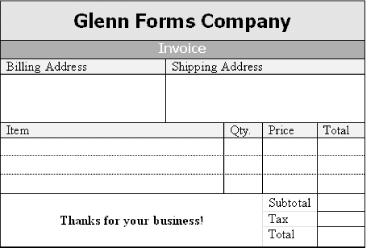Using Forms
Forms can be defined as a structured arrangement of data fields used to collect information and store it in an organized way. Many people use both paper and electronic forms to collect different types of information. Forms can be used for expense reports, invoices, contact information, and much more. Word is a useful tool for creating forms to print or use electronically.
In this section, I step through the creation of an electronic form. This form is an invoice that lets users fill in labeled fields for addresses, items, quantities sold, and prices. The form takes the quantities and prices, calculates line-item totals for the user, and calculates a final total for the invoice, including tax. The form also saves the data in the fields to a comma-delimited text file so that it can be imported into a database later.
Creating a Form
Unless you are creating a very simple form, it’s a good idea to use a table to provide structure to the labels and fields. Figure 15-8 shows the table we will use to create a basic invoice. This is essentially a four-column table, but I have merged some cells, used some background shading, and made some of the cell borders invisible to make the form look nice (see Chapter 10 for more on creating tables). I’ve also filled in the title and the column headings.

Figure 15-8. Using a table to provide structure to a form
My goal is to use this table as ...
Get Word 2000 in a Nutshell now with the O’Reilly learning platform.
O’Reilly members experience books, live events, courses curated by job role, and more from O’Reilly and nearly 200 top publishers.

